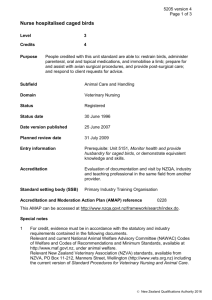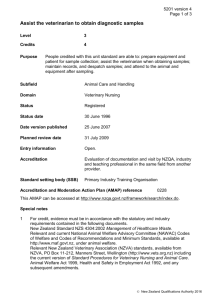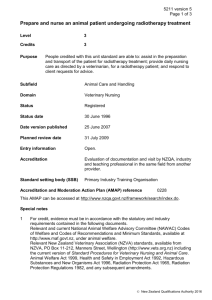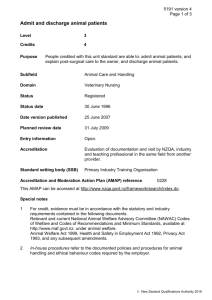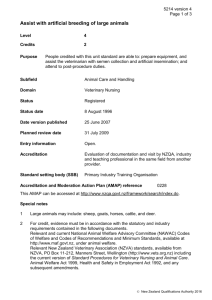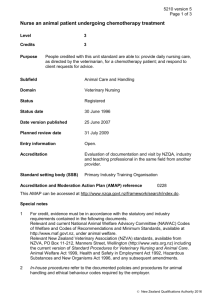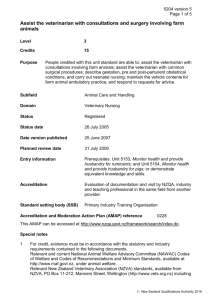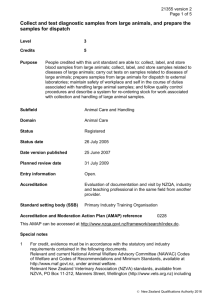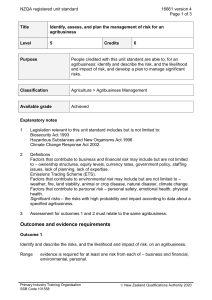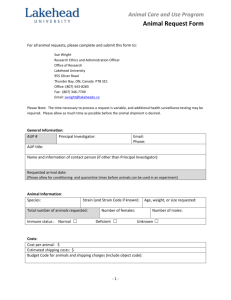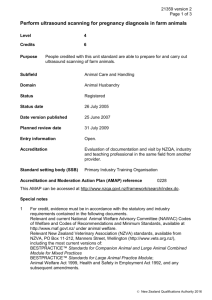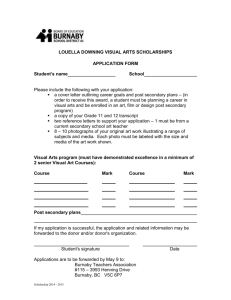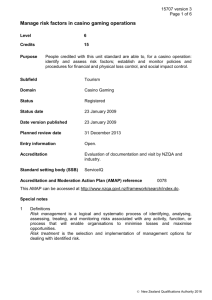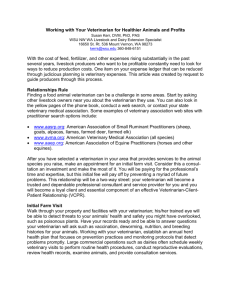5198 Assist in the collection and storage of blood and
advertisement
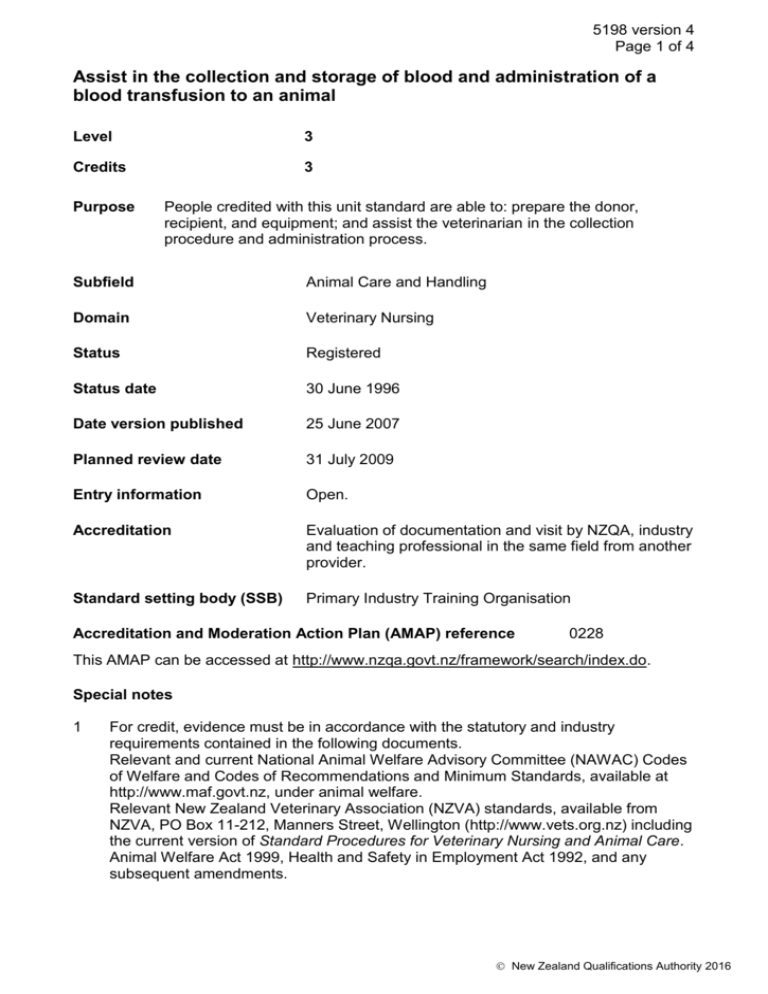
5198 version 4 Page 1 of 4 Assist in the collection and storage of blood and administration of a blood transfusion to an animal Level 3 Credits 3 Purpose People credited with this unit standard are able to: prepare the donor, recipient, and equipment; and assist the veterinarian in the collection procedure and administration process. Subfield Animal Care and Handling Domain Veterinary Nursing Status Registered Status date 30 June 1996 Date version published 25 June 2007 Planned review date 31 July 2009 Entry information Open. Accreditation Evaluation of documentation and visit by NZQA, industry and teaching professional in the same field from another provider. Standard setting body (SSB) Primary Industry Training Organisation Accreditation and Moderation Action Plan (AMAP) reference 0228 This AMAP can be accessed at http://www.nzqa.govt.nz/framework/search/index.do. Special notes 1 For credit, evidence must be in accordance with the statutory and industry requirements contained in the following documents. Relevant and current National Animal Welfare Advisory Committee (NAWAC) Codes of Welfare and Codes of Recommendations and Minimum Standards, available at http://www.maf.govt.nz, under animal welfare. Relevant New Zealand Veterinary Association (NZVA) standards, available from NZVA, PO Box 11-212, Manners Street, Wellington (http://www.vets.org.nz) including the current version of Standard Procedures for Veterinary Nursing and Animal Care. Animal Welfare Act 1999, Health and Safety in Employment Act 1992, and any subsequent amendments. New Zealand Qualifications Authority 2016 5198 version 4 Page 2 of 4 2 In-house procedures refer to the documented policies and procedures for animal handling and ethical behaviour codes required by the employer. 3 Underpinning Knowledge The following areas of knowledge underpin performance of the elements in this unit standard: Element 1 Objectives of blood therapy and blood types Storage, handling of blood and plasma Types and functions of anticoagulants used Characteristics of a suitable blood donor (health, disease, compatibility) Causes and assessment of dehydration Blood volumes and safe sample volumes Element 2 Long term care of donor (dietary, work) Element 3 Immunological and non-immunological causes of transfusion reactions Rate and volume of administration. Elements and performance criteria Element 1 Prepare the donor, recipient, and equipment. Performance criteria 1.1 Procedure for and importance of pre-screening and cross-matching blood is described in terms of ensuring compatibility of donor and recipient. 1.2 Blood collection kits are selected and prepared for use according to individual and quantity required. 1.3 General anaesthetic, if required for donor, is monitored and maintained as directed by the veterinarian. 1.4 Sites for cannula placement are aseptically prepared on donor and recipient, and assistance provided for cannula placement as directed by the veterinarian. Element 2 Assist the veterinarian in the collection procedure. Performance criteria 2.1 Donor animal is positioned as directed by the veterinarian. 2.2 Blood is collected aseptically into collection bags and mixed to prevent cell lysis or coagulation. 2.3 Fluid replacement therapy for donor animal is monitored as directed by the veterinarian. New Zealand Qualifications Authority 2016 5198 version 4 Page 3 of 4 2.4 Site of collection is treated after collection to prevent leakage of blood and local tissue damage. 2.5 Blood is stored in a manner which avoids damage prior to administration. 2.6 Patient is monitored post-procedure, and variations to normal recovery according to individual are recorded and reported to the veterinarian according to in-house procedures. Element 3 Assist the veterinarian in the administration process. Performance criteria 3.1 Administration equipment is aseptically prepared according to species. Range blood giving sets, filters, burettes. 3.2 Patient is positioned and restrained as directed by the veterinarian. 3.3 Blood bag is prepared, according to standard procedures, to optimise success of transfusion. 3.4 Patient is monitored and assessed, according to standard procedures, to ensure patency of intravenous line. 3.5 Medication is calculated and administered as directed by the veterinarian. 3.6 Observations and procedures are recorded and reported according to in-house procedures. Please note Providers must be accredited by NZQA, or an inter-institutional body with delegated authority for quality assurance, before they can report credits from assessment against unit standards or deliver courses of study leading to that assessment. Industry Training Organisations must be accredited by NZQA before they can register credits from assessment against unit standards. Accredited providers and Industry Training Organisations assessing against unit standards must engage with the moderation system that applies to those standards. New Zealand Qualifications Authority 2016 5198 version 4 Page 4 of 4 Accreditation requirements and an outline of the moderation system that applies to this standard are outlined in the Accreditation and Moderation Action Plan (AMAP). The AMAP also includes useful information about special requirements for organisations wishing to develop education and training programmes, such as minimum qualifications for tutors and assessors, and special resource requirements. Comments on this unit standard Please contact the Primary Industry Training Organisation standards@primaryito.ac.nz if you wish to suggest changes to the content of this unit standard. New Zealand Qualifications Authority 2016
